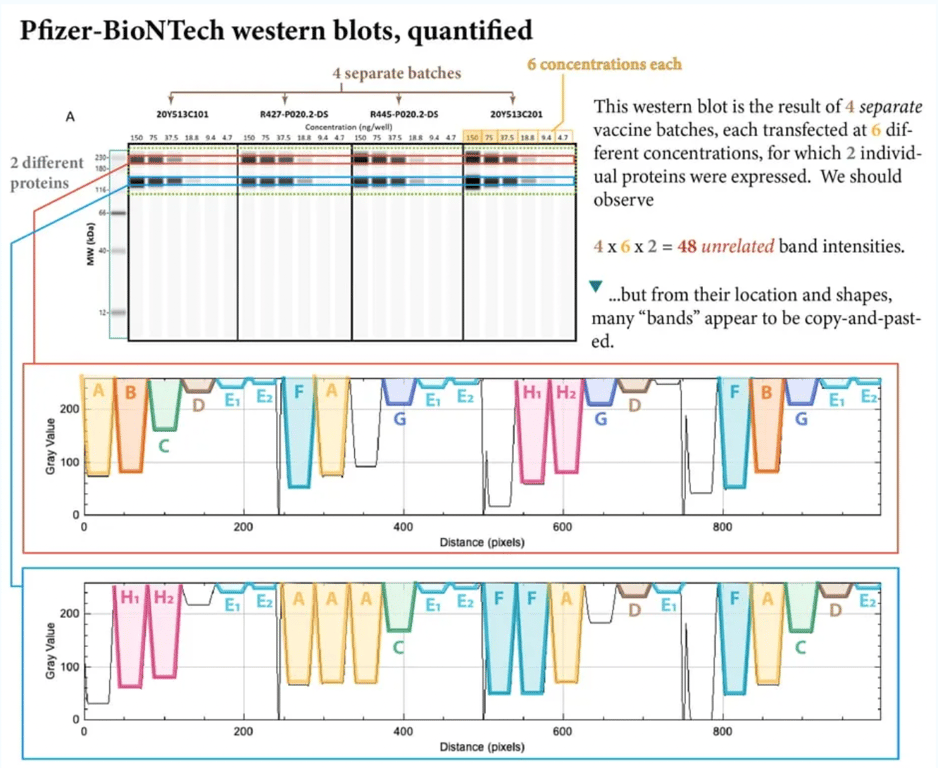Landmark Paper Shows Pfizer/BioNTech’s mRNA Tech is Error-Prone
First published on Trial Site News.
Almost three years on from the mass rollout of the Pfizer/BioNTech mRNA COVID-19 vaccines, and after billions of doses have been administered to almost every age group of the public, including pregnant and nursing mothers- a landmark study by Mulroney et al. from Cambridge University, in collaboration with researchers at the Universities of Kent, Oxford and Liverpool, has proven that the technology used in the mRNA shots is error-prone (prone to ribosomal frameshifting). Consequently, the disturbing results show the unintended production of “off-target” proteins, other than the spike protein, with an ‘unintended’ immune response in the human body.
This should ring alarm bells for the researchers, regulators and all those involved in aggressively pushing these experimental shots on the unsuspecting public but the paper appears to down-play any safety concerns. It is worth noting that two of the researchers Mulroney and Willis having a pending patent application related to mRNA technology.
Prof. Anne Willis from the MRC Toxicology Unit at the University of Cambridge and joint senior author of the report explained in a press release:
“Our work presents both a concern and a solution for this new type of medicine, and result from crucial collaborations between researchers from different disciplines and backgrounds. These findings can be implemented rapidly to prevent any future safety problems arising and ensure that new mRNA therapies are as safe and effective as the COVID-19 vaccines.”
According to the press release, the researchers ‘tested for evidence of the production of ‘off-target’ proteins in people who received the mRNA Pfizer vaccine against COVID-19. They found an unintended immune response occurred in one third of the 21 patients in the study who were vaccinated – but with no ill-effects, in keeping with the extensive safety data available on these COVID-19 vaccines.’
The researchers identified the culprit to this problem which occurs during the translation process of the modified mRNA- a synthetic building block that makes up part of the modified mRNA, which is a key ingredient in the shots. The paper by Mulroney et al. proves that the chemically altered/modified ribonucleotide found in Pfizer/BioNTech’s modified messenger RNA, N1-Methylpseudouridine (abbreviated as 1-methylΨ) triggers ribosomal frameshifting– resulting in the production of “off-target” unintended antigens with “off-target” immune responses.
The authors write: ‘We show that 1-methylΨ is a modified ribonucleotide that significantly increases +1 ribosomal frameshifting during mRNA translation and that cellular immunity to +1 frameshifted products can occur following vaccination with mRNA containing 1-methylΨ. To our knowledge, this is the first report that mRNA modification affects ribosomal frameshifting.’
During the translation process, when the ribosomes (the cell’s decoding machinery) go to read the mRNA code to produce proteins, the 1-methylΨ (which was used to enhance the stability of the mRNA) causes the ribosomes to stall and shift (+1 ribosomal frameshifting) by one or more nucleotides along the mRNA. This shift results in a change in how the codons (a sequence of 3 nucleotides- the building blocks of DNA and RNA) are grouped, resulting in a different sequence of amino acids being incorporated into the growing protein chain. This means, the protein produced can have a different function/structure than expected from the original mRNA sequence.
The researchers state: ‘Although there is no evidence that frameshifted products in humans generated from BNT162b2 vaccination are associated with adverse outcomes, for future use of mRNA technology it is important that mRNA sequence design is modified to reduce ribosome frameshifting events, as this may limit its future use for applications that require higher doses or more frequent dosing..’
They go on to share: ‘These findings are of particular importance to our fundamental understanding of how ribonucleotide modification affects mRNA translation, and for designing and optimizing future mRNA-based therapeutics to avoid mistranslation events that may decrease efficacy or increase toxicity.’
Early this year, the ‘Blotgate’ scandal erupted, known as #Blotgate on social media. My in-depth investigative report for Trial Site News (part 1 and part 2), revealed evidence strongly suggesting that BioNTech fabricated their Western Blot tests, which were used to prove the fidelity of their product to the regulators. A Western Blot is used to identify certain proteins, in this case it was the vaccinal spike protein expressed by the modified mRNA in the Pfizer/BioNTech shots. An anonymous source provided evidence revealing how BioNTech’s automated (computerised) Western Blots had appeared to be ‘copied and pasted’ across four different batches of the vaccine, transfected at six different concentrations.
This expert was able to quantify the bands using an image analysis software, the NIH-sponsored, open-source ImageJ and plotted them in graphs shown above. The vertical axis measures the darkness of the band, in a scale from 0 (black) – 255 (white) and the horizontal axis plots the position. The bands are colour-coded and identified by a letter. Where the same letter and coloured band is seen repeated, demonstrates how these bands have been copied and pasted, either as a group or individually. A possible reason for the researchers at BioNTech to fabricate their results could be to hide the fact that other unintended proteins were being produced- as proven by the recent Mulroney et al. paper.
A group of leading researchers and scientists published a detailed response to the Mulroney et al. paper. An extract from their response reads: ‘The premise for the study reveals a developmental and regulatory failure to ask fundamental questions that could affect the safety and effectiveness of these products. This is no better exemplified by Pfizer’s retired head of vaccine R&D who was quoted in Nature as saying: “We flew the aeroplane while we were still building it.”’
The package insert for COMIRNATY states (3): “Each 0.3 mL dose of COMIRNATY (2023-2024 Formula) is formulated to contain 30 mcg of a nucleoside modified messenger RNA (modRNA) encoding the viral spike (S) glycoproteinof SARS-CoV-2 Omicron variant lineage XBB.1.5 (Omicron XBB.1.5). There is no mention of any other kind of protein. The finding that unintended proteins may be produced as a result of vaccination is sufficient cause for regulators to conduct full risk assessments of past or future harms that may have ensued. We note that regulators have previously failed to insist on the study and assessment of risk of the pharmacology and toxicology of novel spike protein heterotrimers forming after injection of the bivalent COVID-19 modRNA vaccines.
We must assume UK regulators, manufacturers, and international regulatory agencies, including FDA, were apprised of the data many months ago. We await their account of what steps they have taken to investigate why the formation of off-target proteins was not discovered sooner, what toxic effects they may have caused and what steps they are taken to prevent harm in the future and to inform the public of these findings.”
The mainstream media also commented on the landmark paper by reinforcing the downplaying of the significance of unintended proteins being produced in the body, post mRNA vaccination. The Telegraph referred to is as just “a glitch.”
The Telegraph’s Science Correspondent wrote: ‘More than a quarter of people injected with mRNA Covid jabs suffered an unintended immune response created by a glitch in the way the vaccine was read by the body, a study has found.’
I turned to molecular virologist, Dr David Speicher Ph.D.,
Courageous Truth for comment.
“The latest Nature publication by Mulroney et al highlights the problems with the addition of N1-methylpseudouridine (1-methylΨ) into mRNA technology, the very research that Kariko and Weissman received the Nobel Prize. These problems include the formation of unintended and aberrant proteins that will produce off target immune response. Given the emerging scientific literature and the large number of vaccine injured people globally I am not surprised that mainstream media, such as The Telegraph downplay the significance by calling it an “unintended immune response created by a glitch”. Whenever our cells create an abundance of unintended proteins or prevent production of appropriate proteins it could lead to an unintended immune response with a huge potential to cause harm. Instead of dismissing these findings as a “glitch” we need to focus our efforts and determine what is exactly going on. We owe it to all those who are vaccine injured.
This article is a repost from Sonia Elijah’s Trial Site News pages.
Suggest a correction







